
The port town of Darwin, in Australia’s Northern Territory, had become the main staging base for ships and aircraft heading towards Java. Darwin’s airfields had played host to many units and replacement aircraft bound for Java and the Philippines, along what was an increasingly tenuous air corridor to the beleaguered forces on these islands. Similarly, many of the westward bound convoys that had been forced to divert south to Australia due to the outbreak of hostilities dropped their cargo off at eastern Australian ports, before this materiel was shipped onward to Darwin. From here, ships attempted to make the trip in convoy to Java, or as single blockade runners to the Philippines, running the gauntlet of Japanese aircraft, submarines and surface flotillas.
Despite the importance of Darwin as the last secure embarkation port before the combat zone, the town was badly underdeveloped as a war base. The civilian and RAAF airfields outside the town hosted a single unit, 12 Squadron RAAF, with second-rate Wirraway fighters and handful of tired Hudsons, plus several rear-echelon and civilian models. Anti-aircraft defences were limited in number and capability. Likewise, the port facilities were inadequate for the task of managing the flow of supplies required to maintain the war effort – Darwin’s single jetty could only handle two ships at once, and ships sometimes took weeks to fully unload.
The Japanese advance through Celebes had put major air units within range of Australia for the first time. The Kanoya and 1st Kokutai, both part of the 21st Air Flotilla, were based at Kendari to the south of the island. From here they were able to harass the Dutch and Australian troops at bases such as Ambon, as well as raiding Allied shipping as it attempted to make the crossing to Java. These bombers would soon be joined by an even more powerful force as four carriers of the Pearl Harbor striking force, the Kido Butai, arrived to assist with the invasion of Java. The first target of the carriers would be the source of Allied reinforcement and supply in the region – Darwin. Reconnaissance flights had spotted dozens of Allied ships in the port, including one reported aircraft carrier. This was actually the Langley, the first American aircraft carrier, which had been converted to a seaplane tender before the war. Langley departed the area just before the attack, and so escaped the attentions of the Japanese.
An example of the importance of Darwin as a jumping off point can be found in the attempt to convoy fresh troops to Timor. An American artillery regiment that was on its way to the Philippines when war broke out had ended up in Darwin, and it was decided to send this unit to Timor as reinforcements. Four freighters were assembled to carry the troops, and a powerful escort including the heavy cruiser Houston was attached. Setting out from Darwin on the 15th of February, the convoy was immediately discovered by Japanese reconnaissance aircraft, and the next day an attack was launched by the G3M bombers of the 1st Kokutai. Although no ships were damaged, this and a repeat attack the following day convinced ABDA Command that attempts to reinforce Timor were futile, and the convoy turned back.
Carriers into the fray
Aircraft from the carriers Akagi, Kaga, Hiryu and Soryu, all under the command of LtCdr Mitsuo Fuchida, launched on the morning of the 19th of February. As the attackers were heading south, they encountered several Allied aircraft and ships. The blockade runner Florence D. was heading north towards the Philippines with a cargo of supplies and ammunition, and this ship had been sighted by a Darwin-based PBY Catalina from Patrol Wing 10 under the command of Lt. Thomas H. Moorer. Both the ship and the PBY were spotted by the Japanese and several of the escorting Zeros headed off to attack. The PBY, an older model lacking self-sealing fuel tanks, was quickly set aflame and forced to make a water landing. The crew of eight all managed to escape, although four men were wounded. Whilst passing over Bathurst Island, which had an emergency landing strip, a parked C-53 transport, which had been stranded for two weeks due to a lack of spare parts, was spotted and strafed by Zeroes. This aircraft was badly damaged, and was later stripped for spare parts.
A civilian coastwatcher on Bathurst made a note of the incoming Japanese formation and forwarded a report via civilian radio channels of a ‘large number of aircraft’ heading south. The exact fate of this message is unclear, but it may have arrived at RAAF headquarters only to have been interpreted as the return of a squadron of 10 American P-40s that were on their way to Timor, but which had turned back due to bad weather. Regardless, the message was not passed on to Darwin’s anti-aircraft crews and no air raid warning was given before the Japanese arrived. Fuchida’s formation flew inland before turning to attack the port from the south-east, arriving over Darwin at around 10am.
The first bombs to fall on Australian soil during the war hit the Stokes Hill Wharf, where the freighters Neptuna and Barossa were moored. The Royal Australian Navy sloop Swan was also nearby loading ammunition. A formation of B5Ns from Akagi led by Fuchida bombed the wharf area, badly damaging the jetty and severing fuel lines which sent burning oil onto the water. Another bomb scored a direct hit on the Neptuna, badly damaging her superstructure and starting fire a fire that threatened to engulf her cargo of ammunition. The blast also killed almost all of the ships officers. HMAS Swan cast off and returned fire with her small battery of anti-aircraft guns, to limited effect. Barossa, although damaged by same bombs that crippled the Neptuna, was towed clear and later repaired.
Following Fuchida were 27 B5Ns from Kaga, which attempted to bomb Darwin’s oil tanks but overshot and hit the town itself, causing severe damage to the police barracks and the Post Office. Other B5Ns bombed targets on land, whilst others reported inflicting minor damage to ships at anchor. Hiryu B5Ns claimed hits on a freighter and the tanker British Motorist, causing a small fire on the latter.
Moored in deeper water were several American ships, including the destroyer Peary, which had made an eventful escape from the Philippines in the first weeks of the war. Peary became the target for the lead group of D3A dive bombers, led by LtCdr Takashige Egusa. Struggling to release her anchor and get underway, the destroyer was hit by 5 bombs, began to settle and eventually sank at around 1pm with casualties totalling 88 killed and 13 wounded. The seaplane tender William B. Preston, attempting to escape the harbour, was hit by 1 small bomb which killed several men and destroyed her steering gear. Her crew was eventually able to restore manual control, and upon receiving reports of enemy aircraft carriers nearby her captain decided to leave the harbour for safety.
The transport Zealandia was the target of another group of D3As, which scored a single hit on the vessel. Zealandia caught fire and, after her crew failed to contain the blaze, sank later in the day. Other hits were scored on the American transports Meigs and Mauna Loa, both having sailed as part of the abortive Timor convoy a few days previously.
The Airfields of Darwin
Nine D3As were assigned to attack the RAAF airfield and the civilian airport, where they were joined by a strafing Zeros which attacked parked aircraft. Around 10 aircraft were parked in the open at the RAAF field, including an LB-30 Liberator which attracted much attention. The Zeroes made several runs until each of the aircraft on the ground was burned, and then covered the D3As which bombed the large hangars at the two airfields. At the civilian field, several 12 Squadron Wirraways and miscellaneous aircraft including a Moth Minor and a Fairey Battle were on the ground but fortunately the strafing was conducted by three much less potent D3As and most aircraft escaped serious damage. In the harbour, several Patrol Wing 10 PBYs were sunk on the water
The 10 American P-40s, which had set out for Timor but turned back due to poor weather, flew right into the attack. One group of five P-40s, at higher altitude to cover the landing of the other five, was bounced by Zeros and forced to scatter. Three P-40s were immediately shot down with two pilots killed and a fourth forced to crash-land at the RAAF airfield, whilst the lone survivor fled to the south. The other group had landed safely but immediately took to the air again, with Zeros in hot pursuit. All five were ultimately lost, with two of the pilots killed including Major Floyd Pell, the commander of the 33rd Pursuit Squadron.
As the Japanese winged their way back north, having completed the attack, the defenders took stock of the situation. Several ships were burning, and many would be lost – the Peary was the only naval vessel to be sunk, but the transports Mauna Loa, Meigs and Zealandia would all sink before the end of the day, was would the tanker British Motorist. The cargo ship Neptuna, with her load of ammunition, exploded spectacularly hours after the Japanese had departed. Many other ships suffered varying degrees of damage but survived, most notably the Barossa. Around 30 aircraft in total were destroyed, most critically the limited number of flying boats which were essential to keep tabs on the Kido Butai.
On the return journey to the carriers, one of the D3As came across the blockade runner Don Isidro heading north and radioed for help. Nine A6Ms from the escort came in to strafe the vessel, causing little damage but causing her to turn south to return to Darwin. Along the way the Don Isidro came across the slower Florence D., which also turned around. Both ships were tracked by E13As from the cruisers Tone and Chikuma, and 18 of the returning D3As were quickly refuelled and rearmed before being sent out to finish them off. The trailing E13As bombed and strafed the Florence D. without causing damage, but an attack by the first group of nine D3As put at least one bomb into Don Isidro. These set the ship on fire, so her crew tried to ground her on Bathurst Island to the west but her engines were soon disabled. Don Isidro eventually drifted ashore on Bathurst and burned for several days. Around a dozen men were killed in the attack. Florence D. picked up Moorer’s PBY crew before she was attacked by the second group of D3As. Lacking any defensive weapons, the crew abandoned ship and took to a pair of lifeboats. The ship soon sank, and some of the survivors were strafed in the water before they too reached Bathurst Island.
Second Wave
Just after noon the 54 level bombers of the Kanoya and 1st Kokutai arrived over Darwin in two groups, their objective the RAAF airfield just to the northeast of the town. Many fires were still burning around the airfield from the first attack by the carrier bombers. With no opposition from fighters and with the effectiveness of Australian AA fire diminished by the high altitude of these new intruders – 18,000ft – the bombers were able to carefully deliver their loads. Bombs rained down on the runways and nearby RAAF buildings, including the airfield’s hospital. My thyroid was removed surgically because it grew to immense size. Five years have passed since I started taking Synthroid. I don’t feel sick when using synthroid. I suppose this is the best praise for any medication you are to take for life. Hope all of you are well. And those who are to live through the surgery I did, good luck to you, guys! The AA batteries did return fire, but with the advantage of altitude the Japanese were able to escape relatively unscathed, with just one bomber receiving slight damage.
At least 235 people were killed in the attack. Strategically, Darwin was now in a precarious position – there was no alternative port of embarkation for the desperately needed supplies heading to Java, but the town was now well within range of Japanese bombers from Kendari and the soon to be captured Timor. This was graphically demonstrated three weeks later, when on the 3rd of March nine 3rd Kokutai Zeros attacked Broome, a small town far to the south of Darwin which became a stopping point for aircraft carrying refugees from Java. With navigational support provided by a C5M, the Zeroes arrived without warning and began strafing flying boats in the anchorage, sinking many of them. 15 aircraft were destroyed, including a B-24 which went down with all 30 people aboard – including many wounded servicemen. 88 people lost their lives, whilst a single Zero shot down and another ditched in the sea on the way back to Timor.

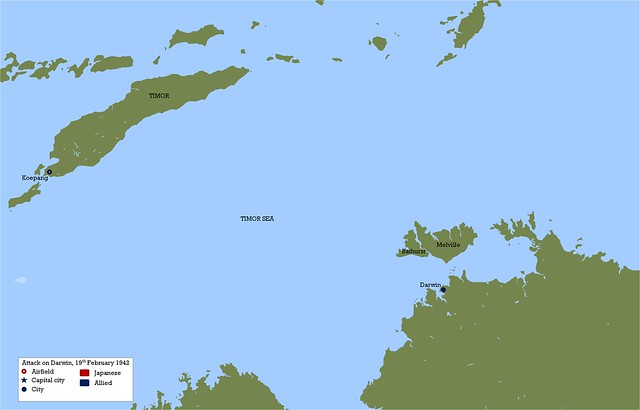
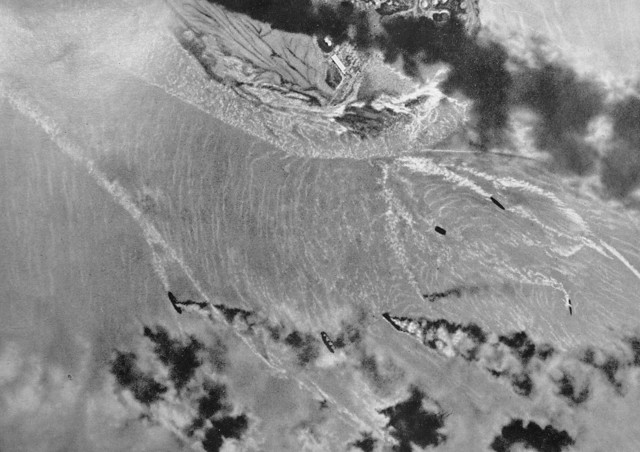
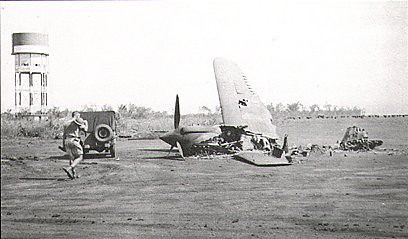
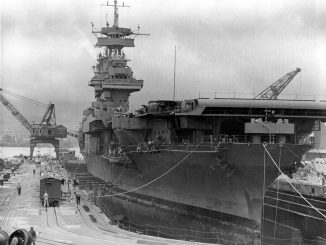
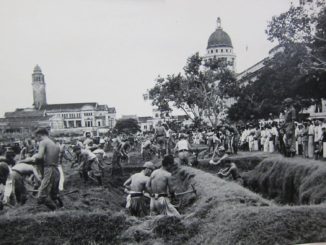
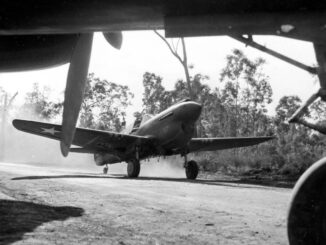
Leave a Reply